Fashion On The Orient Express: Part Two of Our Journey
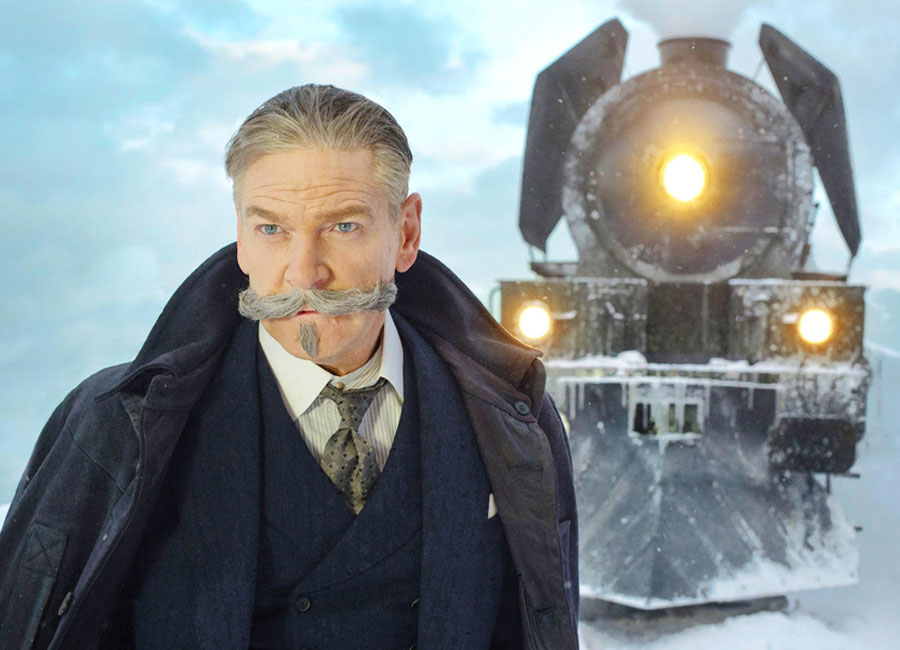
Photo: Fox Home Entertainment
Academy Award-winning costume designer Alexandra Byrne reveals the secrets behind recreating 1930s fashion for Murder On The Orient Express.
Throughout her career, English costume designer Alexandra Byrne has moved seamlessley between historical period and fantasy. Byrne recently wrapped on the upcoming Mary, Queen of Scots starring Margot Robbie and Saoirse Ronan and her extensive screen credits range from Finding Neverland, Hamlet and Elizabeth: The Golden Age to Thor, The Avengers, Doctor Strange and Guardians of the Galaxy, where at Marvel Byrne has spent years defining the look of superhero blockbusters.
With Murder on the Orient Express, the Academy Award-winning costume designer moves from the Marvel Cinematic Universe to what I call the Marple Cinematic Universe.
On our journey, Byrne explained how she went from little grey cells to grey tweed and dressed Agatha Christie’s most infamously fastidious detective.
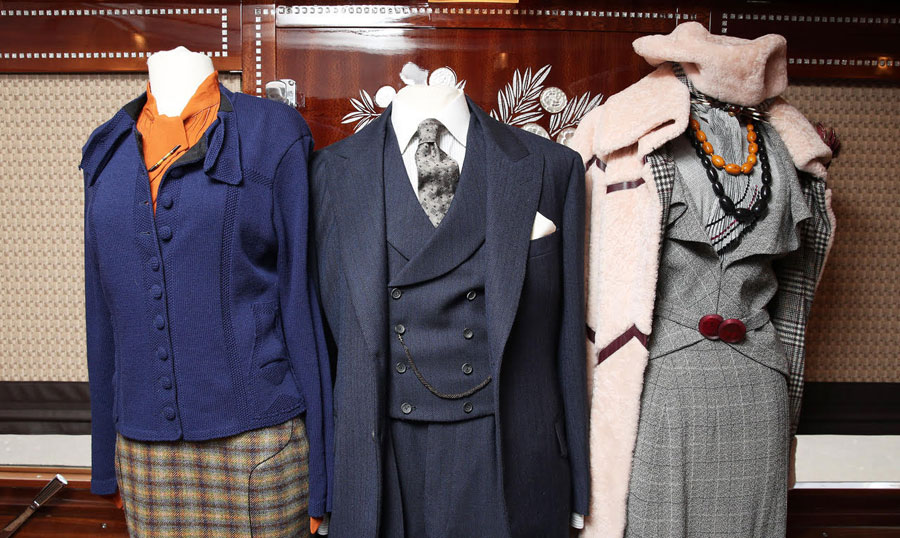
For the costumes, Byrne and director Kenneth Branagh worked from the assumption that few of the characters on the train are actually dressed as who they really are. “They’re dressed as somebody for that journey,” Byrne recalls. “We did a whole background timeline on these characters so that we understood who they really are, who they’re pretending to be and how they put their clothes together, and what it means.” The details range from the pleating on a trouser as a clue to identity to the glimpse of character in a billowing sleeve wiping blood from both dagger and hands that’s a winking visual reference to Macbeth.
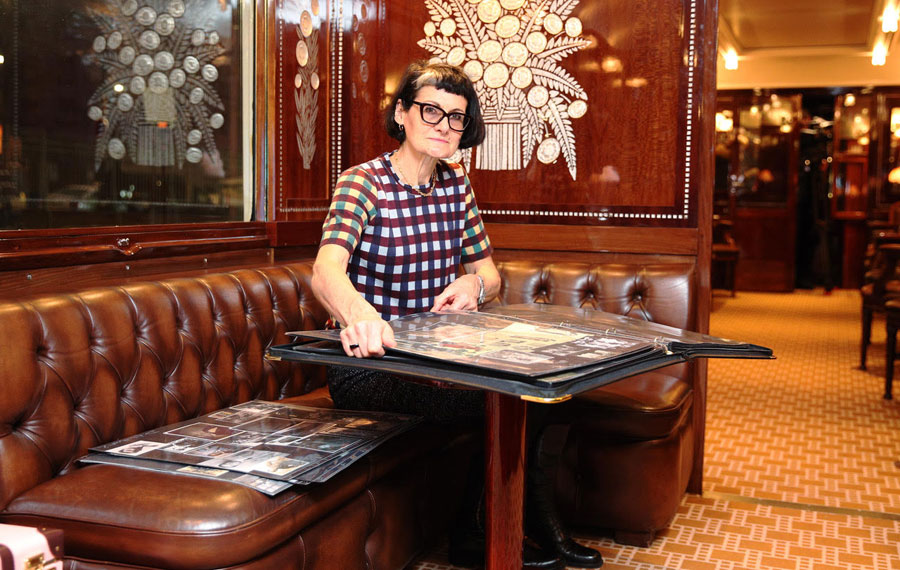
“You swamp yourself in images and gradually distill yourself down, then there’s my editing,” she says of visual research. Then mood boards are all put around the room where the seamstresses and cutters are working and gradually, everybody sees something different in them and gradually it begins to be absorbed in the style of the clothes.”
As the Orient Express train chugged and lurched to its destination on the rails, Byrne and I perused her mood boards —eclectic clippings from film, paintings and fashion catalogue advertising of the era, and discussed dressing the part and inspiration for several principal characters.
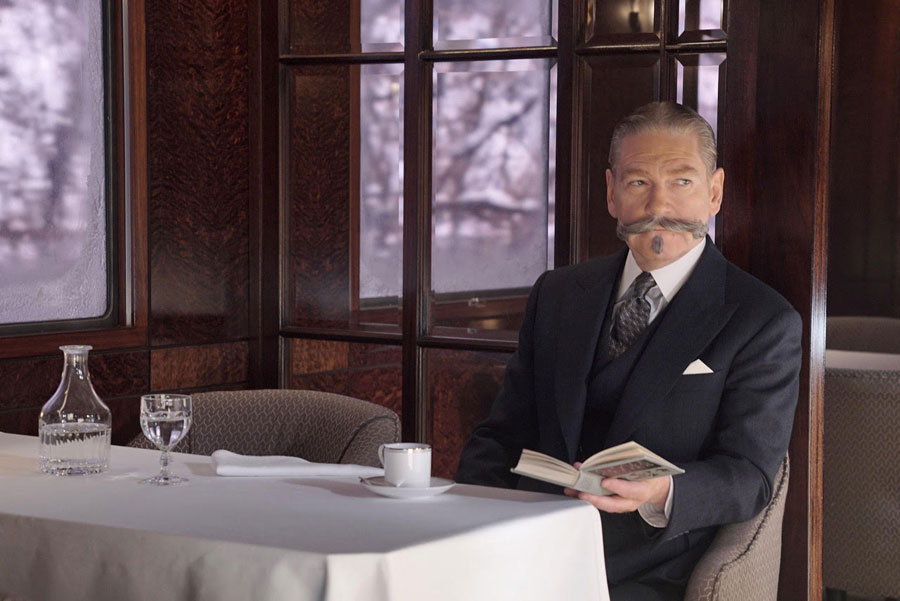
The vanity of symmetry: Kenneth Branagh as Hercule Poirot
“In working with Ken he was very keen for Poirot to have a military background,” Byrne recalls, originally a Belgian police officer, then on the front in the army during a brutal battle. “We felt that gave Poirot a kind of vanity through decision and through precision, replacing peacock vanity.”
He would not have been that wealthy, he would not have that many clothes. “I think a lot of costume dramas overdress people – the reality is he probably would have had two suits – an evening suit, and there was no leisure wear.”
Knowing that we were going to be some action sequences and needed more than one suit duplicate for Poirot, Byrne enlisted Scottish mill Brydon Thompson recreate cloth of the period for his suits. “It was much heavier 18oz wool than is used in menswear tailoring now. Today it’s a thick fluffy suiting, whereas in the 1930s it was a much tighter, drier weave.”
“Ken was very keen that the knot on the tie was immaculate and identical, part of a dressing routine. For example in the fight sequences when he loses a collar stud,” she continues, “something that would be as distressing and as invasive to Poirot as somebody having their front teeth knocked in!”
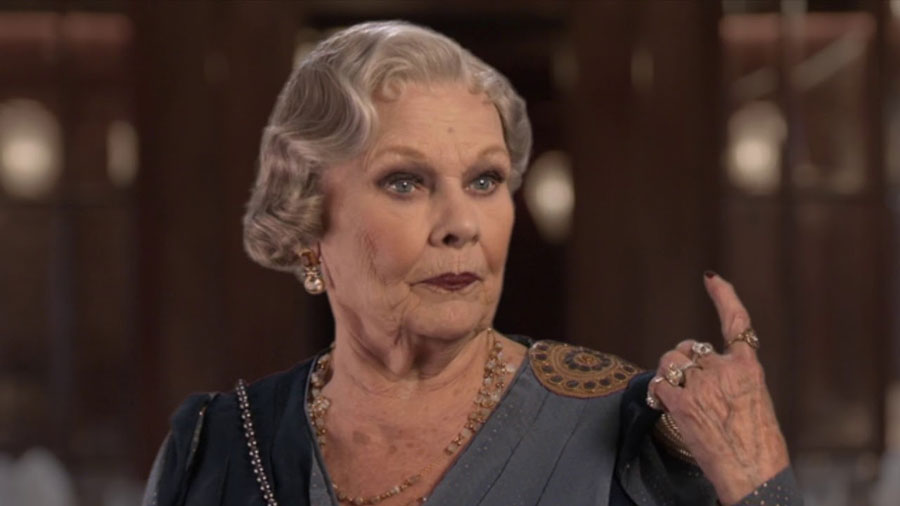
Imperious pearls: Judy Dench as Princess Dragamiroff
“I think, Madame, that your strength is in your will – not in your arm,” is what Poirot says to the imperious Russian grande dame in the novel. We meet her on the page thus: “She sat very upright. Round her neck was a collar of very large pearls which, improbable though it seemed, were real. Her hands were covered with rings. Her sable coat was pushed back on her shoulders.”
In Murder on the Orient Express, the dowager strides onto the train below a spray of millinery plumage and ample fur wraps. One memorable dinner gown is encrusted with texture befitting a deposed Russian noble: embroidered with buttons, pearls and pinwheels inspired by classic Jeanne Lanvin. She wears ropes of pearls.
Although Byrne used opulent velvets and jacquards in blues and purples, she otherwise downplayed the clothing details. “The great thing about Judi is that she has these amazing twinkly eyes, and playing a Princess, she would have a lot of jewelry, that she had managed to get out of Russia during the revolution and had maybe repurposed. I took quite a simple line on her clothes so that the jewelry and her eyes could really sparkle.” Georgian and rivière necklaces are layered and her every finger is adorned with rings — including a large cabochon emerald – that the costume team designed and made from scratch.
READ PART THREE: VINTAGE COCKTAIL HOUR
Fun facts: Dench made her acting debut in 1957, as Ophelia in Hamlet in Liverpool with John Neville. She also plays Hecuba in Kenneth Branagh’s own Hamlet (1996), which happens to be the first of Branagh and Byrne’s many feature film collaborations. And while Byrne won her Academy Award for the costumes in Elizabeth: The Golden Age, in which she dressed Cate Blanchett as the renegade queen, Dench won hers playing Shakespeare in Love’s version of that same Tudor monarch.
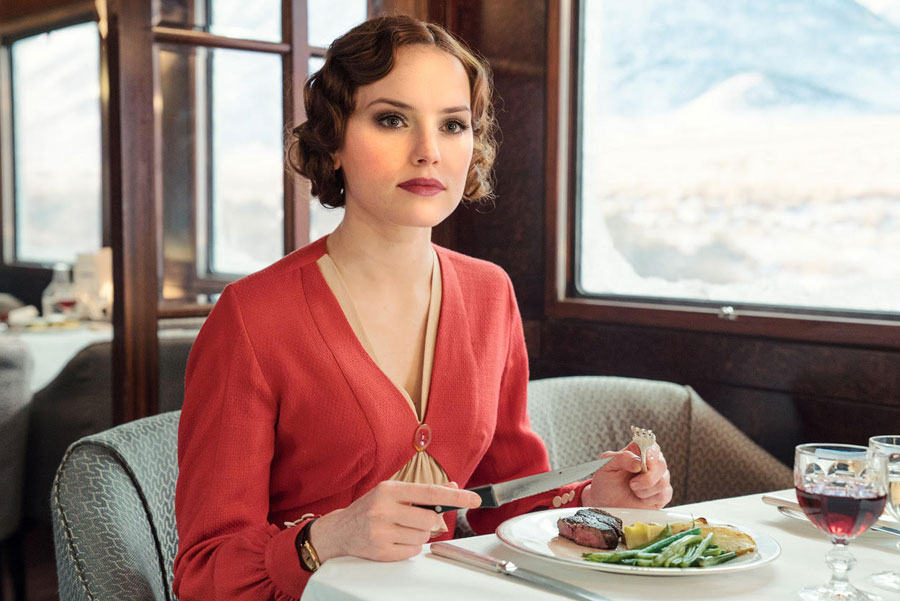
Thoroughly modern millinery: Daisy Ridley as Mary Debenham
“She’s the closest character, I think, to Agatha Christie herself,” Byrne says. Feisty, independent, and working as a teacher and governess to support herself financially.
In her penchant for tailored suiting with separates, Mary is a lot like the contemporary working woman. The costume Byrne has brought on display in the train is a mix of earthy tweeds and knit that Mary wears out in the snow, after the avalanche and the train heating goes off. They don’t quite match. “She had to be very practical in keeping warm. Her wardrobe wasn’t extensive enough to have a coordinated piece for everything so she layers what’s in her case,” the costume designer explains.
Mary’s navy suede footwear is also an accessible current interpretation of the period’s popular T-bar style that for Byrne, was also rooted in pragmatism. “I took the decision to not spend a lot of money to have expensive bespoke costume shoes made,’ she explains. “You can do very good sourcing through parts of Europe that are good enough to not break the period—and not break the budget.” The contemporary style is by Chie Mihara, a Japanese designer whose collected is made in Spain.
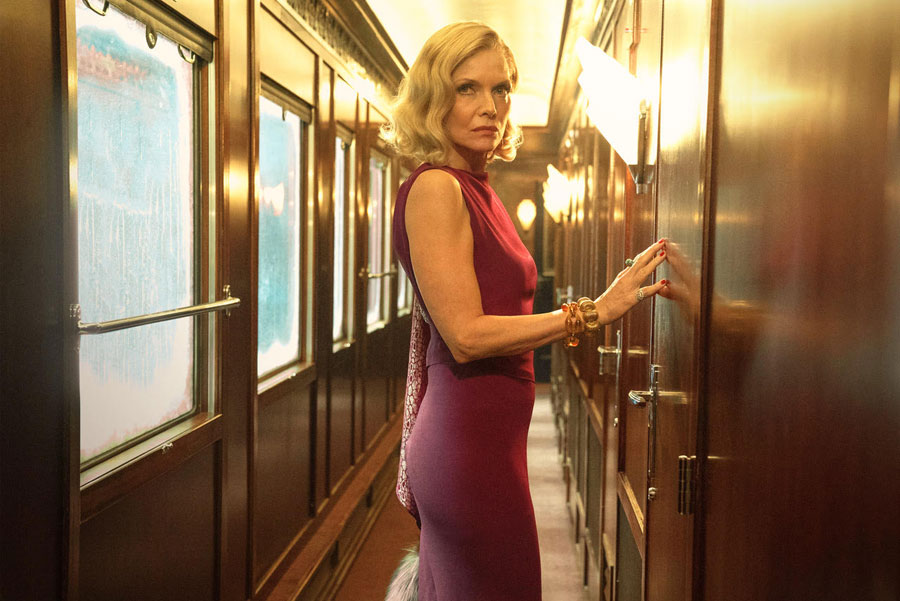
More is more: Michelle Pfeiffer as Linda Arden
“Her first entrance when she arrives in Istanbul to board the train she’s obviously making an entrance. She’s an actress, she’s used to dressing for attention.”
As Linda Arden, celebrated Broadway actress, Pfeiffer’s double identity is a heartbroken women pretending to be an extrovert: for the journey she creates the character of Caroline Hubbard, “a West Coast and rather brash tourist husband-hunter,” Byrne says.”
She wears a ruffled suit and sumptuous pink bouclé coat with inset leather caped over her shoulders as she boards. “I wanted it to be a bit too big so that she’s bashing people with it, that it’s a big swooping statement entrance. And then just the clash of checks and black-and-white pattern, a bit too much jewellery, multiple handbags,” she explains. “As we go through the film she’s a professional tourist who themes her dressing to where she’s been or where she’s going — which is why when we’re in the mountains she’s in a ski suit because they’re going out into the snow.”
Of the passengers, Pfeiffer would have packed the most clothing—enough to rival Noël Coward, who once boarded the train with 27 trunks (one of the visual references is of Marlene Dietrich on the platform surrounded by luggage). Her wardrobe includes knits sweaters with asymmetrical pleated bows and several chubby fur capelets, a tawny houndstooth jacket with inset fur sleeves, suiting and masculine tweed trousers tucked into Austrian hiking boots.
“There’s a sense of fun and ostentation without, I hope, it being too much,” Byrne says. “She’s one of those women that’s too loud for the room and to get that balance on film is quite difficult. Her character doesn’t understand the notion of less is more but to do that on camera so that it’s not comic is quite a fine balance. I worked closely with [hair and make-up designer] Carole Hemming to not have everything one-note, to build in layers. And contradictions.”
The magenta evening dress Pfeiffer wears is based on an original piece from the 1930s and because it’s bias-cut, it doesn’t have hanger appeal and looked very sad, the costume designer recalls. But it can transform on the body. “There was an amazing moment when she put it on and that was it,” Byrne laughs.
Christie also writes a great deal about the passengers various dressing gowns, and while we don’t see them Byrne says the production produced them all according to the author’s descriptions. “They’re somewhere in the luggage!” she laughs. “I think their night clothes and pyjamas are much truer to who they are—I don’t think other than Mrs Hubbard they expected to be discovered.” The turban Pfeiffer wears was a technical and narrative consideration: “We discussed with Michelle that she would want to be herself as Linda Arden and the blonde wig is Caroline Hubbard, so we thought the turban allowed her to be true to herself.” It’s also the perfect flourish for an actress who, even alone in her compartment, would have a penchant for drama.
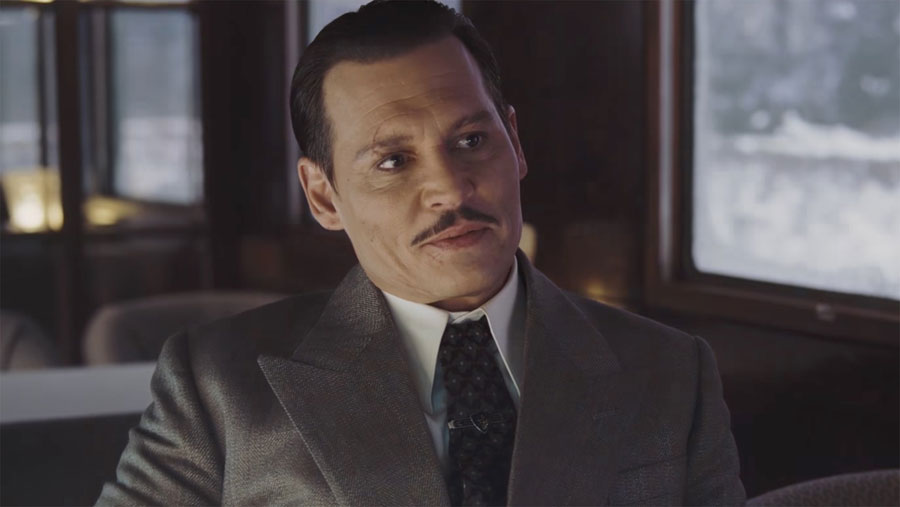
Gangster style: Johnny Depp as Mr. Patchett
Among other things, 1934 was the year of gangsters — of Bonnie and Clyde and of John Dillinger. Since Johnny Depp’s ruthless thug Ratchett meets a similar fate, it’s fitting he should dress like one. The wide peak lapels, faint pinstripe wool and wide split collars are in the exaggerated style of a continental menswear, probably made in Italy. The distressed leather trench coat is an ostentatious extravagance.
“After the war tailoring was beginning to change. Obviously a gentleman in England wore a black coat and pinstriped trousers, but the most important thing for a gentleman of that period was to dress appropriately to your class. It was quite frowned upon if you were working as a clerk and you wore a black coat and pinstriped trousers, it would have ben very gauche. And inappropriate.”
In research I also discovered the differences of English, American and European tailoring. They all have fine details, things you don’t think about like how in England the pleats on the trousers turn in and in America, they turn [face] out. But then of course the upper classes were all bespoke so they could also put their own vanitie and eccentricities on top of that.
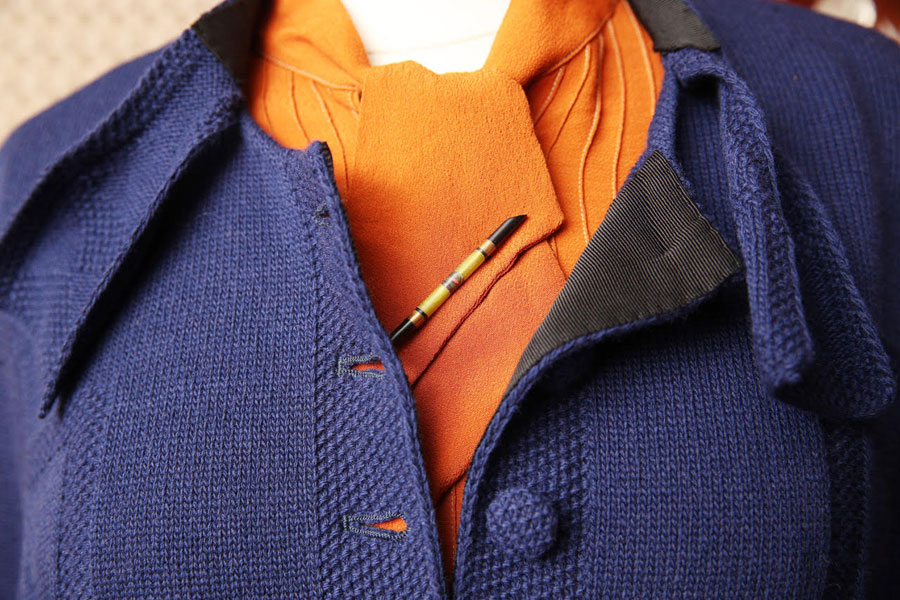
A few vintage modern tips for today
Fashion is always pulling from the past, and the 1930s were arguably the first definitive modern style era— one that still exerts influence on fashion today. The challenge of dressing with a nod to special occasion or period theme without appearing costumey is all in the mix. In real life, add a little inflection through details that capture the mood, with vintage touches pulled from the specific era.
Several passengers on my Orient Express trip did exactly that— American influencer Dawn McCoy, for example, went for the jugular with an elaborate two-tone fur jacket over textured layers and accessories in eye-catching fire engine red. She perfectly channeled Pfeiffer’s dramatic, more if more character. Many other female passengers also wore elegant tailored day dresses with face-framing real and faux fur stoles, collars and coats.
My own outfit for the day was similarly inspired by Dench’s heady mix of jewels and fur, and Pfeiffer’s exuberant pattern play as I climbed aboard the Orient Express with a Canadian style twist. I opted for a marled wool pattern coat by Ewanika over bright stripes, bronze boots from Gravity Pope and a vivid green collar from Linda Lundström (who has a new Thermakota outdoor range). I adorned it with several antique rhinestone fur clips, fitting not only because that jewellery was at the height of its popularity in the 1930s, but because in one scene, Pfeiffer’s character wears a similar clip on her blouse.

The sleuth as…superhero?
Near the end of Murder on the Orient Express when Poirot confronts the twelve assembled passengers with his solution, he strides along the track towards them. For this suspenseful scene, Poirot does not wear his own strictly tailored Edwardian topcoat but a garment that billows behind him as dramatically as Doctor Strange’s red cape. Since in the past decade Byrne has memorably dressed virtually all the caped crusaders of Thor, The Avengers and Guardians of the Galaxy on screen for Marvel, I could not resist asking about that moment.
“The idea of that came very much from Ken,” Byrne says. “He wanted Poirot to be disheveled for the first time and the cloak that he picks up is actually one of the crew’s cloaks—a waxed cotton protective cloak for one of the engineers on the train. He just wanted something over his shoulders in a way that Poirot doesn’t normally wear clothes.”
“I think the superhero baggage comes entirely from me,” she adds with a laugh, “because I’ve done a lot of capes! But all the superheroes have to have massive harnesses and rigs and all kinds on them,’ Byrne explains. “That one didn’t, it’s a real piece of clothing. Only in the design and the cutting – we knew we wanted the collar to do that but it’s not rigged out. It’s technically not a superhero cape in any way.”
Mystery, solved.